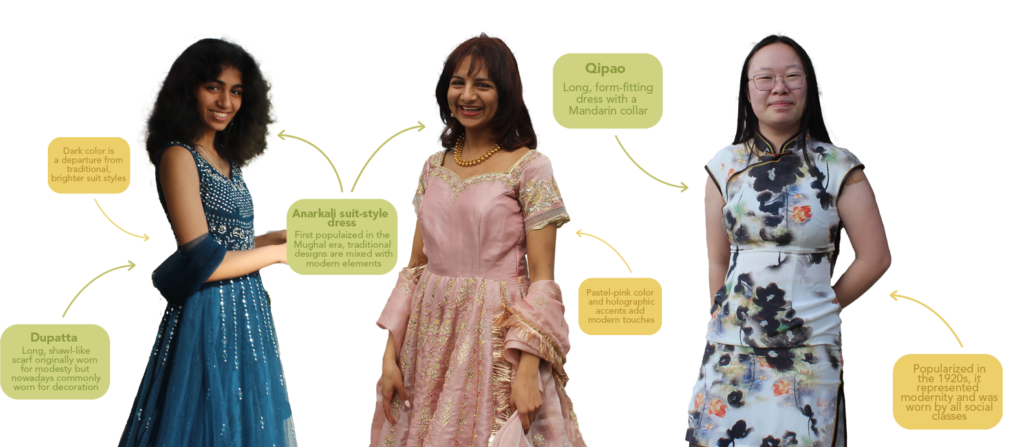Prom dresses provide unique opportunity to show culture

Laurel Wang | The Chronicle
As prom season approaches, some Mason High School (MHS) students are redefining the dance floor as a runway.
Young women attending prom night this year are looking to deviate from the Western-style dresses typically found at prom. Instead, students are looking to their cultural heritage for some inspiration to diversify their school dance look and represent their unique history.
Senior Tanvi Reddy is wearing an Anarkali suit-style dress with a dupatta, a form of traditional Indian clothing. An Anarkali suit incorporates a long, tunic-length top and a slim, fitted skirt. A dupatta is a long, shawl-like scarf worn to complement the dress. In past years, she has worn Western-style dresses to celebrations and weddings but wanted to showcase her heritage specifically at prom.
“Originally, I did want to go with a Westernized dress,” Reddy said. “But as I was looking, I was like, ‘I don’t feel like me.’ And for senior year, I wanted to have a dress that felt like me, so I can not only feel like myself but also represent my culture.”
Like Reddy, Junior Diya Pandhi is also wearing an Anarkali suit-style dress as an homage to her Indian heritage. Her dress is a dark Prussian blue with silver sparkles. Such dresses are usually worn to celebrations, like Garba, a traditional dance.
For Pandhi, wearing a traditional dress goes beyond paying homage to her culture. Choosing cultural clothing was a sustainable option that also helped her save money. Pandhi initially brought the dress for a wedding but thought prom would be a good opportunity to re-wear the dress.
“Between AP exams, school fees, and tickets, there are a lot of costs around this time of year,” Pandhi said. “If you have something that fits well and looks really pretty, I might as well just make use of it and save $200 on a [new] prom dress.”
Senior Rachel Yang wore a qipao, or cheongsam, a form of Chinese traditional dress, to Homecoming this past fall. She echoed Pandhi’s sentiment that choosing a qipao, which she was gifted, was a sustainable choice alongside being a fashion statement.
“A dress is gorgeous, but you only wear it once,” Yang said. “After the event, you basically don’t use it again.”
Yang was inspired by seeing others show off their culture by wearing traditional clothing to MHS formal events in the past. Following their example, she felt confident to wear something that deviated from the typical prom dress.
“I know a couple of people that [wear cultural clothing] every year,” Yang said. “They made me feel more confident about wearing traditional clothes because I wasn’t the only one doing this ‘weird thing’ where I wear a Chinese traditional dress or something.”
Reddy said that she also gained confidence about what she wears as she has matured throughout high school and would like to wear traditional clothing more in her everyday life. Although wearing her cultural clothing is a deviation from typical Western everyday wear, Reddy feels comfortable expressing herself through her clothing.
“I used to feel insecure about [wearing traditional clothing] because it was ‘weird’, but now I’m at the point where I don’t care about what anyone thinks about how I dress,” Reddy said. “Dressing how I want is definitely a confidence thing. As I grew up, I found myself more, and I’m able to express myself without feeling anxiety.”
Pandhi said that she hopes wearing an Anarkali dress at prom will positively represent Indian culture. To her, clothing could help subvert negative stereotypes about Indian culture by celebrating culture instead.
“I feel like Indian traditions are often put down,” Pandhi said. “I haven’t really seen anything [on social media] that’s positive, and a lot of people are ashamed because there’s a lot of stereotypes. So I think wearing cultural clothing would kind of demonstrate how beautiful Indian culture can be.”
Graphic by Alisha Verma
